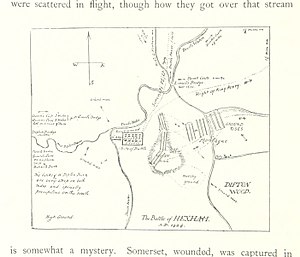The Battle of Hexham took place on 15th May 1464. It was a small but significant victory for the Yorkists, led by Richard Neville. Northumbria had been a Lancastrian stronghold. Following the defeat at the Battle of Towton, Henry VI had fled to the North East. Lancastrian supporters had followed, turning the region into a bastion of resistance. Following the Battle of Hexham, that resistance petered out.
The build up to the Battle of Hexham
In April 1464, the Lancastrians had been thwarted in an attempt to prevent the Yorkists striking a deal with the Scots. At the Battle of Hedgeley Moor, Yorkist troops had succeeded in defeating the Lancastrian army. This had allowed a Scottish delegation to visit York and conclude a peace settlement with the Yorkist government of England.
With the prospect of support from Scotland now gone, the Lancastrian cause was desperate. They took a decision to resist. Controlling a number of Castles in the area and with seasoned soldiers at their disposal the intention was to rise in rebellion before Edward IV could raise an army in the south.
The Battle of Hexham
The Duke of Somerset moved the Lancastrian army through Northumbria in April of 1464. It gathered troops from the garrisons in the area. Learning of this, Richard Neville, the Earl of Warwick, was sent as a forward vanguard of Edward’s army to the North East. Neville’s force arrived quickly. Neville’s brother, who had been victorious at Hedgeley Moor, marched his army along the Tyne. It found Somerset camped near Hexham.
The Battle itself appears to have been brief. Accounts suggest that the Lancastrians were ill prepared for the sudden arrival of a Yorkist force. They hastily threw up a defensive line by their camp. Behind them was the River Tyne. As the size of Montagu’s army became visible to the defenders, many deserted. Those that did not probably numbered around 500. They were quickly overwhelmed and forced into the river.
As the battle drew to a close the Earl of Warwick arrived. At this point any faint hope of turning the table was over.
Consequences of the Battle of Hexham
Though the battle was small in terms of the numbers involved, it was of significance. Somerset was captured and immediately executed. Three other Lancastrian lords, Lord Roos, Lord Hungerford and Sir William Tailboys were captured, taken to Newcastle and executed in the following days.
The Lancastrian baggae train included some £2000, a considerable amount at the time.
Henry VI was no longer safe in the North East, Lancastrian resistance there was over. Henry was able to evade capture for the time being. He was found in Clitheroe, Lancashire, some time after the battle. This made the yorkist position in the Wars of the Roses very dominant. Indeed, it was only through disputes between Warwick and the King that the Lancastrian cause was able to seriously recover.
Links
Historic England’s record for the Battlefield.
Causes of the Wars of the Roses – Course of the War of the Roses – Events of the War of the Roses
Battles in the Wars of the Roses
First Battle of St. Albans – Battle of Blore Heath – Battle of Ludford Bridge – Battle of Northampton – Battle of Wakefield – Battle of Mortimer’s Cross – Second Battle of St. Albans Battle of Ferrybridge – Battle of Towton – Battle of Hedgeley Moor – Battle of Hexham – Battle of Edgecote Moor – Battle of Losecote Field – Battle of Barnet – Battle of Tewkesbury – Battle of Bosworth – Battle of Stoke Field
Documents, Maps and Evidence
The Rous Rolls – Paston Letters – Edward IV Roll
People and periods
British History – The Wars of the Roses – The Plantagenets – The Tudors – King Henry IV – King Henry V – King Henry VI – King Edward IV – King Edward V – King Richard III – King Henry VII – Margaret of Anjou
Schoolshistory – teaching resources for Key Stage 3, GCSE and A Level history


